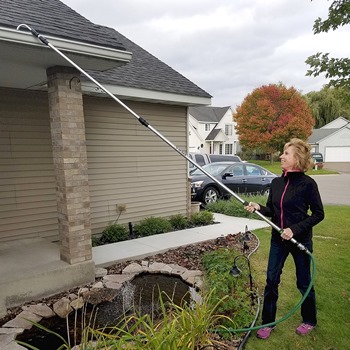Cleaning gutters using a power washer can be easily performed following these steps:
- Step 1. Prepare the area that needs to be cleaned.
- Step 2. Choose the right PSI rate for cleaning gutters.
- Step 3. Attach the pressure washer gutter cleaner.
- Step 4. Choose the right detergent for gutter cleaning.
- Step 5. Rinse the gutter with fresh water before applying detergents.
- Step 6. Apply detergents on the gutter for sanitation using a pressure washer.
- Step 7. Rinse away the chemicals using fresh water.
- Step 8. Clean the nearby area by removing the dirt resulting from the gutter cleaning process.
The steps needed to safely pressure wash gutters are described in detail below.
Tools Needed to Clean Gutters
- Pressure washer
- High-pressure hose for power washers
- Pressure washer gutter cleaner
- Pressure washer extension wand
- Pressure washer soap
- Pressure washer water broom – optional
- Safety goggles
- Tarp
Gutter Cleaning Tips
 Never use a ladder for a gutter pressure washing job. Power washers can be dangerous if used while on a ladder because they can produce recoil that can cause the operator to fall off the ladder.
Never use a ladder for a gutter pressure washing job. Power washers can be dangerous if used while on a ladder because they can produce recoil that can cause the operator to fall off the ladder.- Always use a pressure washer extension wand that is long enough to reach all the gutters of the building.
- Start from the top and direct the debris down to the ending of the gutter.
- Always wear safety goggles while cleaning gutters with a pressure washer because debris and small rocks can be propelled, which can cause severe injury.
Best Way to Clean a Gutter With a Pressure Washer
Step 1. Prepare the Area for Pressure Washing.
Before starting to clean a gutter using a pressure washer remove all the mobile plants, outdoor furniture, bikes, tools, or other objects that might deteriorate in contact with under pressure water. If there are plants or objects that cannot be removed, it is recommended that they be covered with a tarp. This procedure is needed so that the operator has enough room to move around without tripping and also to protect things from the debris that might fall from the gutters.
Step 2. Choose the Right PSI Rate for Gutter Cleaning.
Pressure washing gutters requires around 1500 PSI. If the gutters are not thoroughly attached to the house, a lower pressure is suitable. Residential power washers that are used for light-duty cleaning tasks are rated between 1000 PSI and 2000 PSI. If a medium or heavy-duty machine is operated, checking the minimum pressure rate is advised because some units do not go below 2000 PSI.
Step 3. Set Up the Pressure Washer Gutter Attachment.
Pressure washer gutter cleaners are easy to install as they are usually equipped with quick-connect fittings. A pressure washer gutter attachment needs to be connected to an extension wand but it also needs a nozzle to work properly. To clean the outside of the gutter, use a wide nozzle spray, and for the inside, a narrower one.
Step 4. Choose the Right Chemicals.
Choose a detergent that is specially formulated for pressure washers, as regular chemicals can damage the pump and other pressure washer parts. Try to use a fully biodegradable pressure washer soap that does not harm the environment as it might come in contact with plants and soil nearby.
Step 5. Use Clean Water to Rinse the Gutters.
Before applying the chemicals, use uncontaminated water to remove leaves and dirt from the gutters. The leaves that come down can be used as soil fertilizer if they do not come in contact with detergents.
Step 6. Apply Soap for Deep Cleaning.
Pressure washing gutters using detergents is optional and has to do with how much dirt has gathered inside the gutter. If the procedure is repeated on a regular basis, the use of chemicals might not be required.
Changing the nozzle to a black one, suited for soaps, is not optional. This needs to be performed after turning the engine and the water supply off, and after all the pressure has been removed from the unit.
Step 7. Remove Chemicals.
After pressure washing the gutters using soap, the chemicals need to be rinsed thoroughly with clean water. Avoid letting the detergent dry on the gutters as it will be harder to remove if it doesn’t rain.
Step 8. Clean the Nearby Area.
The area near the building remains dirty after pressure washing the gutters because all the debris and leaves gather here. Cleaning this area can be done using a regular broom, but this procedure is done faster using a pressure washer. After detaching the gutter cleaner and reducing the wand’s length, use a wide nozzle or a pressure washer broom to clean the nearby area.

